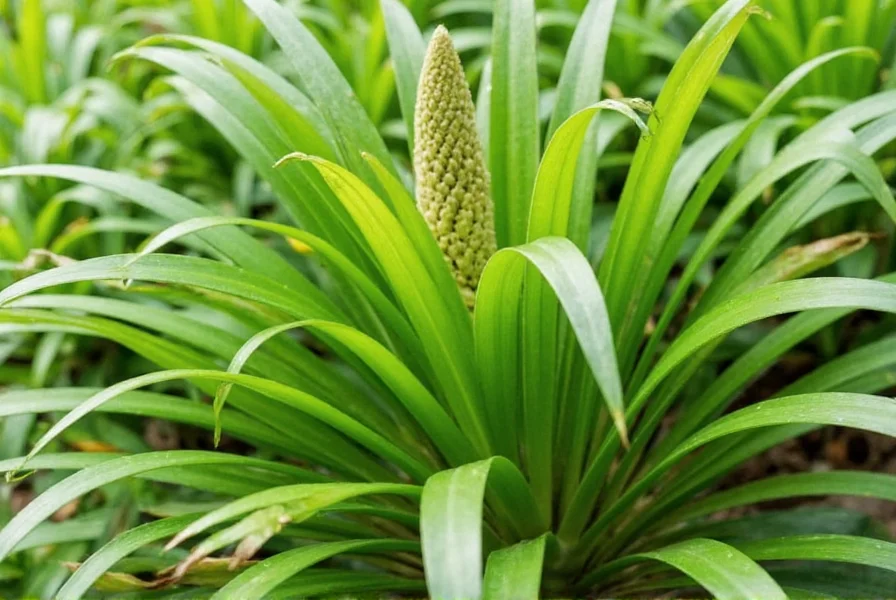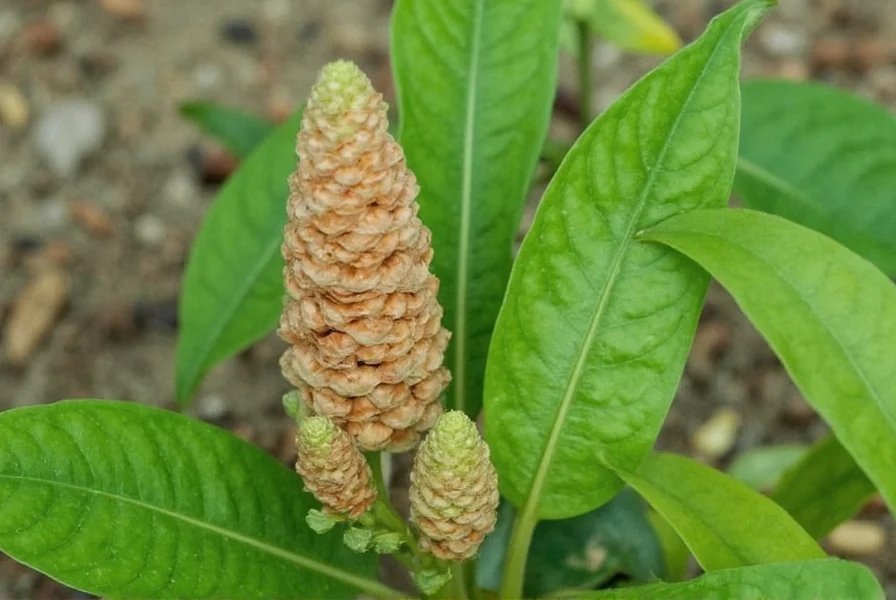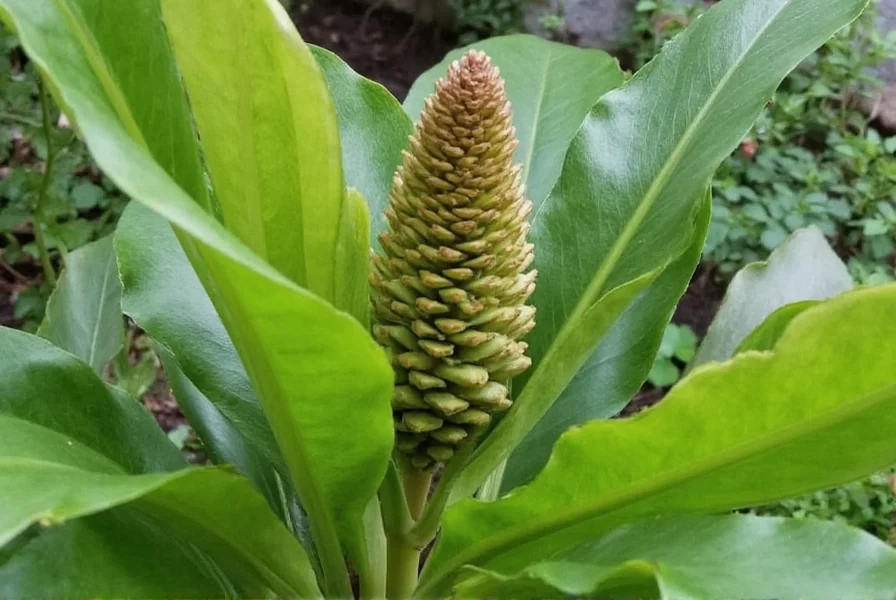The cone ginger plant (Zingiber zerumbet) stands as one of the most distinctive members of the Zingiberaceae family, captivating gardeners and botanists alike with its unique characteristics. Native to the tropical regions of Southeast Asia, this perennial rhizome plant has spread throughout Pacific islands and now thrives in USDA hardiness zones 8-11. Understanding how to grow cone ginger plant successfully requires knowledge of its specific environmental preferences and growth patterns.
Botanical Characteristics of Cone Ginger
Reaching heights of 3-6 feet with a similar spread, cone ginger develops lush, tropical foliage that creates an impressive architectural statement in landscape design. The plant produces pseudostems formed by tightly wrapped leaf sheaths, with lance-shaped leaves growing up to 18 inches long. What truly distinguishes this species is its inflorescence—a dense, cone-shaped structure that begins as a vibrant green and matures to a striking red hue.
Unlike regular ginger plants, the cone ginger's flower head contains a clear, fragrant gel within its bracts. This secretion, which smells faintly of citrus, has earned the plant its alternative name "shampoo ginger" due to traditional use as a natural hair cleanser in Pacific Island cultures. The gel appears approximately 6-8 months after the cone emerges, making timing crucial for those interested in harvesting this unique substance.
| Feature | Cone Ginger (Zingiber zerumbet) | Culinary Ginger (Zingiber officinale) |
|---|---|---|
| Primary Use | Ornamental, traditional medicine | Culinary spice |
| Rhizome Flavor | Bitter, not suitable for cooking | Spicy, pungent, ideal for cooking |
| Flower Structure | Pinecone-shaped with gel secretion | Less prominent, no gel secretion |
| Medicinal Compounds | Zerumbone (anti-inflammatory) | Gingerol (digestive aid) |
Growing Requirements for Optimal Cone Ginger Plant Care
Successful cone ginger plant care begins with understanding its natural habitat preferences. This tropical species thrives in partial shade conditions, particularly benefiting from morning sun and afternoon protection in warmer climates. While it tolerates full sun in cooler regions, intense afternoon sun in zones 9-11 can scorch the delicate leaves.
Soil requirements prove critical for healthy growth. The ideal soil for growing zingiber zerumbet maintains consistent moisture without becoming waterlogged. A rich, well-draining mix containing organic matter supports optimal development. Gardeners frequently achieve success with a blend of:
- 50% quality potting soil
- 30% compost or well-rotted manure
- 20% perlite or coarse sand
During the active growing season (spring through fall), regular watering maintains consistent soil moisture. Reduce watering frequency during winter dormancy, but never allow the rhizomes to completely dry out. In container gardening situations, the cone ginger plant winter care strategy requires moving pots indoors when temperatures drop below 50°F (10°C).
Propagation and Planting Techniques
Propagation occurs primarily through rhizome division, making cone ginger plant propagation accessible even for novice gardeners. The best time for division aligns with the beginning of the growing season, typically in spring. Select healthy rhizome sections containing at least one bud eye, allowing cut surfaces to callous for 24 hours before planting.
When establishing new plants, position rhizomes just below the soil surface with the bud eyes facing upward. Space divisions 18-24 inches apart to accommodate the plant's eventual spread. Gardeners practicing cone ginger plant care in containers should select pots at least 14 inches in diameter with adequate drainage holes.
For those wondering is cone ginger edible, the answer requires nuance. While not toxic, the rhizomes possess a bitter flavor unsuitable for culinary applications. Traditional medicinal uses exist, but consult a healthcare professional before internal consumption. The gel from mature cones serves externally as a hair treatment but lacks the culinary versatility of regular ginger.
Seasonal Care and Maintenance
Understanding the cone ginger plant flowering season proves essential for maximizing ornamental value. Flowering typically occurs from mid-summer through fall, with cones developing sequentially along the stem. Each cone matures over several weeks, changing color from green to pinkish-red as it prepares to secrete the characteristic gel.
Fertilization supports vigorous growth and abundant flowering. Apply a balanced, slow-release fertilizer every 6-8 weeks during the growing season. Organic options like compost tea or fish emulsion provide excellent nutrition while improving soil structure. Avoid high-nitrogen fertilizers that promote excessive foliage at the expense of flowering.
Pest management remains relatively straightforward with this resilient plant. While generally pest-resistant, watch for spider mites in dry conditions and slugs during wet periods. The cone ginger plant's natural compounds provide some protection against common garden pests, reducing the need for chemical interventions.
Landscaping Applications and Design Considerations
Landscape designers increasingly incorporate cone ginger for its dramatic tropical appearance and architectural form. The plant serves effectively as:
- A striking focal point in shaded garden areas
- Background planting for smaller tropical specimens
- An accent plant near water features
- A container specimen for patios and entryways
When designing with cone ginger, consider its mature size and growth habit. The plant's lush foliage creates excellent screening, while the distinctive cones provide months of visual interest. Pair with complementary plants like ferns, caladiums, or elephant ears to create a cohesive tropical theme.
For gardeners in cooler climates wondering about growing zingiber zerumbet in containers, this approach offers significant advantages. Container cultivation allows for easy movement indoors during winter months and provides better control over soil conditions. Choose containers with adequate drainage and use a high-quality potting mix specifically formulated for tropical plants.

Traditional Uses and Modern Applications
Across Pacific Island cultures, the cone ginger plant has served multiple traditional purposes beyond its ornamental value. The gel secreted by mature cones functions as a natural shampoo and hair conditioner, explaining its common name "shampoo ginger." Traditional medicine systems have employed various plant parts for treating inflammation, digestive issues, and skin conditions.
Modern research has identified zerumbone, a compound concentrated in the rhizomes, as possessing significant anti-inflammatory and potential anti-cancer properties. While promising, these findings remain in the preliminary research stage. Those interested in zingiber zerumbet medicinal uses should consult healthcare professionals before using the plant for therapeutic purposes.

Troubleshooting Common Growing Challenges
Even with proper care, gardeners may encounter challenges when growing cone ginger. Yellowing leaves often indicate overwatering or poor drainage—a critical consideration for those learning cone ginger plant care. Adjust watering practices and ensure adequate soil aeration to correct this issue.
Failure to flower typically stems from insufficient light or nutrients. While cone ginger tolerates shade, optimal flowering requires at least 4-6 hours of filtered sunlight daily. Applying a phosphorus-rich fertilizer during bud formation may encourage more abundant flowering.
In colder regions, winter dieback represents a normal part of the plant's growth cycle. Rather than indicating problems, this dormancy period allows the rhizomes to conserve energy for spring regrowth. Proper cone ginger plant winter care involves reducing water and protecting rhizomes from freezing temperatures.
Conclusion
The cone ginger plant offers gardeners a unique combination of ornamental beauty, cultural significance, and botanical interest. By understanding its specific requirements for light, soil, and water, growers can successfully cultivate this striking tropical specimen even outside its native range. Whether grown for its distinctive pinecone flowers, traditional uses, or landscape value, Zingiber zerumbet provides months of visual interest and connects modern gardeners with centuries of cultural tradition.
Frequently Asked Questions
Is cone ginger the same as regular ginger?
No, cone ginger (Zingiber zerumbet) differs significantly from culinary ginger (Zingiber officinale). While both belong to the Zingiberaceae family, cone ginger produces a fragrant gel in its flower cones and has bitter rhizomes not suitable for cooking. Culinary ginger contains the spicy compound gingerol in its rhizomes, making it valuable in cooking and traditional medicine.
Can you eat cone ginger?
The rhizomes of cone ginger are technically edible but extremely bitter and not recommended for culinary use. The gel secreted by mature flower cones serves externally as a hair treatment but lacks the culinary versatility of regular ginger. Some traditional medicine systems use processed cone ginger, but consult a healthcare professional before internal consumption.
How do you care for cone ginger in winter?
In USDA zones 8-11, reduce watering as temperatures drop and allow natural dieback. Mulch heavily (4-6 inches) to protect rhizomes from freezing. In colder zones, dig up rhizomes before first frost, allow to dry for 24 hours, and store in peat moss or vermiculite at 50-60°F (10-15°C). Container-grown plants should move indoors to a bright location with reduced watering during dormancy.
Why isn't my cone ginger flowering?
Lack of flowering typically results from insufficient light (needs 4-6 hours of filtered sun), inadequate nutrients, or immaturity. Cone ginger usually begins flowering in its second growing season. Ensure proper phosphorus levels through balanced fertilization, and avoid high-nitrogen formulas that promote foliage over flowers. Patience often proves necessary, as young plants may take 12-18 months to produce their first cones.
How often does cone ginger produce new cones?
Mature cone ginger plants typically produce new flower cones every 3-4 weeks during the primary flowering season (mid-summer through fall). Each individual cone develops over 4-6 weeks, changing from green to pinkish-red as it matures. Under optimal conditions, a healthy plant may produce 8-12 cones per growing season, with each cone secreting its characteristic gel approximately 6-8 months after emergence.











 浙公网安备
33010002000092号
浙公网安备
33010002000092号 浙B2-20120091-4
浙B2-20120091-4